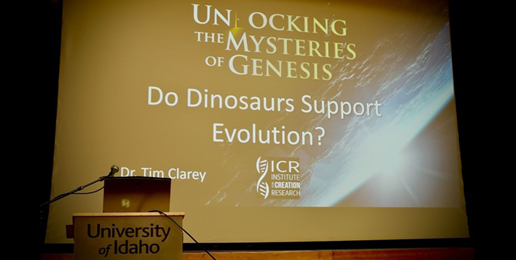
“When you are drawing dashed lines you are making things up…
[evolutionary theories] are just false stories made-up to fit their narrative.”
~Dr. TimClarey
Dr. Tim Clarey of the Institute For Creation Research (ICR) holds a PhD in Geology from Western Michigan University, and two Master degrees pertaining to Geology and Hydroscience. Additionally, he worked as an Exploration Geologist for Chevron and Full Professor and Geosciences Chairman for Delta College.
In this lecture, Dr. Clarey draws upon Scripture and years of experience, using them to debunk evolutionary theories that pervade schools and public institutions.
Clarey begins by noting how scientists play with timelines like monopoly money, adding and taking millions of years without consequence. Earth dating is skewed with inaccurate methods, biased sampling, and an agenda to prove, he says. Currently scientists date the Earth between 232 and 66 million years old.
Dr. Clarey points out a little-known flaw with dating and publishing, stating “they pick the numbers they want…you have to conform to be published.”
This flaw manifested itself in 1999, when a fake bird-dinosaur was glued together, fooling the scientific community for six months. Passing x-rays and CT scans, the hoax was dated and dubbed a new species: Archeoraptor. Even National Geographic was fooled, publishing about the ‘missing link’ between birds and dinosaurs. Only when evidence of stolen fossils surfaced was the dinosaur revealed as faux.
“But rocks don’t lie, people do,” Dr. Clarey says as he emphasizes the empirical evidence. Focusing primarily on oil, ancestry, and fossil conditions Dr. Clarey finds, “there is no explanation…except the Earth is young.”
Dr. Clarey explains that oil is biodegradable, slowly breaking down over the years. On the surface, oil spoils within twenty years. Stored underground, however, crude oil is largely protected from the bacteria and chemical reactions breaking it down. Either way, though, oil cannot last millions of years.
Concerning ancestry, evolutionary theories rely heavily on ‘ghost lines’ and ‘missing links’. However they are exactly that: missing. The fossil record has no evidence of the ancestors that dinosaurs supposedly evolved out of. Even esteemed evolutionist Dr. David Weishampel admits, “No direct ancestors have been discovered for any dinosaur species…my list is an empty one.”
Making up ancestors has become a favorite pastime for evolutionists, and Dr. Clarey points out a few tricks. One method for ‘finding’ ancestors is making up a species. Dr. Clarey says if you took 60 people in a room, evolutionary scientists would find 6 different species. Then, they would use inaccurate dating measures to claim some species evolved out of others.
There are hundreds of differences within triceratops, T-Rex, and other dinosaurs. But their natural variations don’t warrant different species. Similarly, humans vary in skin color, skull shape, and behavior, but nevertheless they are the same species, and aren’t evolving, he says.
Another trick for making up a species is finding feathers. Evolutionary scientists claim feathered fossils are proof of an evolutionary process: birds evolving from scaly dinosaurs. While this idea is popular among the scientific community, it has been repeatedly debunked.

Dinosaurs naturally vary in shape, size, and behavior much like humans
First of all, it supposedly took millions of years for birds to evolve out of dinos. But bird fossils are found in the earliest layers, buried with or even beneath the dinosaurs they supposedly evolved from.
Secondly, the best evidence of dino/bird evolution are small feather-like structures found on fossils. However, leading paleontologist Dr. Stephen Brusatte says the feather-like structures are not related to feathers at all, but composed like hair. During multiple experiments, collagen (which is the primary protein in hair) was found to break down during fossilization, creating a feather-like appearance. Paleontologist Dr. Phil Bell of the University of New England says without question dinos had scaly skin and were not growing feathers.
Aside from oil and ancestry, evolutionary theory cannot explain fossil conditions. To begin with, it is evident that sudden burials and floods have occurred. Fossils of land-based dinosaurs are almost always mixed with fossils of marine life, and both show signs of being ‘frozen in time’. Fossils of dinosaurs are being found in the midst of fights, building nests, or even casually eating. Evolutionists can’t explain why marine fossils are being found inland. Their only solution is adding a couple million years to the earth’s age.
In 2005, evolutionists were shaken by the discovery of dinosaur flesh when soft-tissue, blood, and collagen were found in a T-Rex fossil (which was supposedly 68 million years old). Since then, scientists have discovered hearts, livers, retinae, scales, blood vessels–and more–in dinosaurs supposedly 145-200 million years old! However, blood vessels die quickly and collagen (the toughest protein in the body) only lasts for a maximum of thousands of years.
Dr. Clarey says evidence for Young Earth Creationism is everywhere: The existence of oil, the ancestry of dinosaurs, and the fossil conditions all point towards a young earth. At the same time Dr. Clarey says this evidence is being covered up, as “they won’t teach you this in school…there is no good evidence for these things other than the Earth is young.”




















